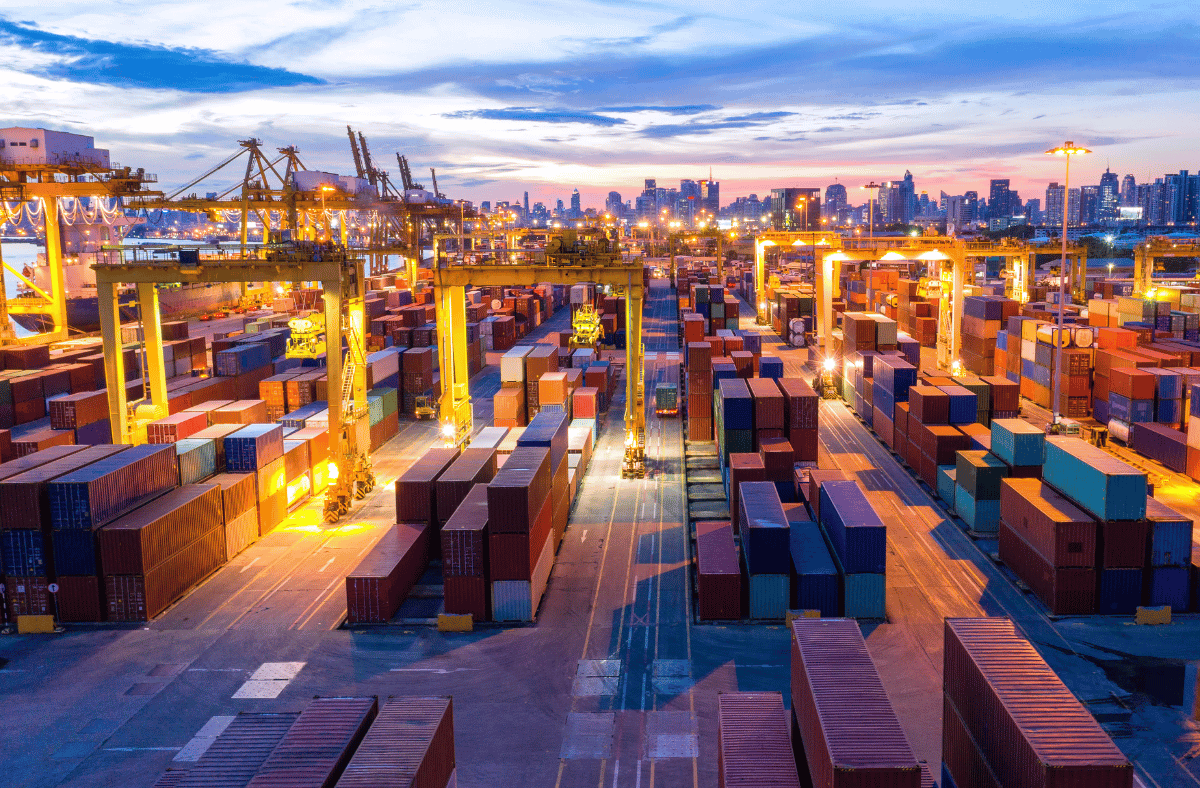2022 is here and the mantra for the year ahead might be “Get familiar with the unfamiliar.”
By now, most international businesses have learned to adapt and remain flexible with the uncertain economic climate, supply chain struggles, and COVID-19 variant waves. Within this resiliency, they have found the ability to become comfortable with the fact that much of the international trade ecosystem’s future remains unpredictable.
To adapt, they’ve applied better risk mitigations strategies; found alternative shipping, manufacturing, and export providers; adopted digital marketplaces; and applied innovative financial or funding solutions.
As we are fully living in the “new normal,” the struggles have been visceral for many industries. Such as travel, tourism, leisure, and restaurants, but for others, opportunities have arisen. For instance, some technology businesses like Kognitive Spark, a software company based in New Brunswick, saw an increase in clients, applications, target market, and revenue because their augmented reality solution provided much needed remote maintenance solutions to onsite staff, stated to Bernadette Fernandez, in a panel discussion with FITT last year.
Similarly, Fernandez noted that: “I’m also not sure how many businesses want to get back to what we knew as normal… [before] everything was done in excess and we see a lot of things that we want to do differently or less of, like going into a workplace and having a more balanced life. I know a lot of companies now who are actually more successful because they are now able to offer an alternative to travel.”
Her points highlight how those who were able to adapt last year will, this year, now fully become immersed in their new normal. Innovating, becoming digitally savvy, and, yes, growing comfortable with the unknown along the way.
Bearing these notions in mind, we’ve got a list of 10 Global trade trends we’ll be watching in 2022, many of which prove that, as a whole, the international business community has accepted unpredictability as a norm that they can and must thrive in.
1. Moderate economic growth with regional and industry variability
According to the WTO, world merchandise trade volume growth could rise to 4.7% in 2022,” while Export Development Canada’s Global Economic Outlook—Autumn 2021 forecast predicts a 5.5% increase in world economic growth in 2022. These projections echo the Centre for Economics and Business Research’s (CEBR) estimate that the global economy is expected to grow by 4% in 2022.
While there is growth, most are noting that 2022 will be a year of decelerated growth when compared to 2021. COVID-19 variants, supply chain issues, and the tapering off of support programs all contribute to the slowdown.
Similar to last year, the economic progress will vary from region to region, with developed nations making gains more quickly than developing nations as a result of vaccine distribution, economic policies, and political situations. The World Bank reports that EMDEs (emerging market and developing economies) “…are expected to suffer substantial scarring to output from the pandemic, with growth trajectories not strong enough to return investment or output to pre-pandemic trends over the forecast horizon of 2022-23.”
2. Continued supply chain struggles, but potential improvements dependent on COVID-19 restrictions
In 2021, supply chain struggles dominated the headlines. While many predicted shortages of certain supplies, most did not foresee the host of other issues that were in store for the global supply chain. From pallet and container shortages to major port closures and delays—to even the totally unexpected Suez Canal Crisis, the troubles were numerous. Many of these issues will continue into 2022—though, possibly, might not be as bad.
The WTO predicts that “Supply-side issues such as semiconductor scarcity and port backlogs may strain supply chains and weigh on trade in particular areas, but they are unlikely to have large impacts on global aggregates. The biggest downside risks come from the pandemic itself.”
While Export Development Canada notes, “We expect supply chain and shipping shortages—major issues at the moment—to improve through 2022. But our projections are far from risk-free: Failure to contain COVID-19 conclusively could result in further lockdowns. Inflation could lead to central banks tightening more than the economy can handle, putting the brakes on growth.”
Sarah Schiffling and Nikolaos Valantasis Kanellos noted in an article for Fast Company that the “bullwhip effect”—when changes in customer demands cause repercussions in other supply chain areas—could become a prominent issue in 2022. In 2021, there were already indications of this:
“A combination of the crash in demand for new cars and higher demand for devices like laptops and game consoles (for lockdown entertainment) contributed to the semiconductor-chip shortage,” they noted.
On the flip side, some companies might experience the opposite problem: having too much stock on their hands once consumer demands are fulfilled—requiring businesses to be precise and restrained with their planning.
Businesses and consumers will also have to contend with price increases due to supply problems, but as these become more commonplace, many hope that cooperation from governments and trade bodies will help ease the situation. Factor in COVID-19-related labour shortages within the supply chain force, and there may be quite a few bumps to overcome throughout the year.
3. Hybrid logistics strategies
With COVID-19 lockdowns and border and travel restrictions rising and falling throughout 2020 and 2021, many companies are re-thinking their logistic strategies this year, likely diversifying to create hybrid approaches to their plans.
Last year, some considered localizing supply chains while others diversified and expanded theirs. This year, those who don’t want to set all their eggs in one strategy basket will create a mix of local and expanded networks. This will ensure that if one supply avenue fails, another can take its place.
Similarly, companies that relied on just-in-time manufacturing—the practice of keeping a lean inventory to create products as they are needed (to reduce costs)—began adding just-in-case logistics to their planning. Because of current supply chain issues, many added elements of just-in-case approaches to their plans so they could store more inventory and materials to meet consumer demands during supply chain disruptions.
“Some companies will probably continue to improve their just-in-time with a sprinkle of just-in-case. Others will bring production of some products closer to home markets while also keeping offshore-production facilities to serve local markets,” noted Schiffling and Kanellos in their FastCompany article “Supply chain issues will continue well into 2022—with a twist.”
4. Climate Change Disruptions
“Months’ worth of rainfall fell in the space of hours in China and parts of Europe saw severe flooding, leading to dozens of casualties and billions in economic losses. A second successive year of drought in sub-tropical South America reduced the flow of mighty river basins and hit agriculture, transport and energy production,” said WMO Secretary-General Prof. Petteri Taalas in a United Nations Report.
His words, echo the onslaught of climate change disasters and disruptions—including deadly, record-breaking heatwaves and floods across North America—that took place in 2021, and that are predicted to continue into 2022.
Projections internationally for climate-related disruptions are more serious than ever, with U.K. government researchers recently reporting that next year will be one of the hottest on record, with average global temperatures about 1.96 degrees Fahrenheit over pre-industrial averages.
These forecasts are among the many climate change headlines that will continue to dominate the news in 2022. As climate change disruptions will create human, environmental, and economic disasters throughout the year, they will spur global governments to simultaneously tackle emissions reductions policies and regional planning for natural disasters and severe weather impacts.
5. Increased Climate-Change Policies and Initiatives
As climate change is becoming a more urgent focus globally, many governments, climate activist groups, and businesses are increasing their efforts to adopt circular economies and curb greenhouse gasses and carbon emissions. The recent COP26 summit, for example, garnered massive attention for its convergence of global powers who came together to work toward solutions to climate change. The summit concluded with nations agreeing to phased-down unabated coal production and sped-up timelines for their “nationally determined contributions” or NDCs.
In response to climate change effects, other nations like Canada are increasing carbon taxes. US President, Joe Biden, is pushing for a goal of reducing the US’s greenhouse gas emissions in half by 2030.
International businesses are also increasing their efforts to reduce their carbon footprint. Retailers like Patagonia are implementing a “No more virgin petroleum fibers by 2025” pledge. Alphabet, Google’s parent company, is pledging to become the first major company to run on carbon-free energy by 2030.
6. Political Sanctions
As 2021 wrapped up, there were signs of political strife between many of the world’s major nations. The US, Canada, Australia, and the UK are imposing a diplomatic boycott of the Beijing Winter Olympics over concerns about China’s human rights abuses, while, on the horizon, there could be potential conflicts with a Russian invasion of Ukraine, and China’s political moves with Taiwan and Hong Kong.
The US Commerce Department already is in the midst of blacklisting several Chinese technology companies. This is in response to their alleged high-tech surveillance of the Uighur people. China has already imposed sanctions against four members of the U.S. Commission on International Religious Freedom in 2022. Those looking ahead this year can expect more sanctions between countries, with trickledown effects for industries caught in the crosshairs.
7. Data Security Enhancements
Businesses were already increasing their reliance on technology prior to the start of the pandemic. But now, almost two years into the pandemic, they’ve accelerated their approaches and are now fully immersed in them.
As digital is the only way for many global businesses in 2022, efforts to improve data security will increase. Due to “not only the growth in the number of security breaches but also the rising costs associated with them. A single hack can be enough to severely affect an enterprise’s bottom line as well as reputation. Having the right precautions and business continuity processes in place is vital for long-term success and brand confidence,” notes Simon Waller in a The Fast Mode article.
Unsurprisingly, CNET agrees with these sentiments, noting that in 2022, “The expectation of a ramp-up in hacks, attacks and data theft comes after a massive jump in ransomware—takeovers of computer systems that remain locked down until a ransom is paid—that spilled into consumers’ lives in 2021. Cyberattacks that shut down oil transporter Colonial Pipeline and meat packer JBS USA contributed to temporary gas price increases and meat shortages in parts of the US.”
As a result, governments and businesses globally are increasing their efforts and budgets for data security. They are doing this by making server storage locations, database protection, and prevention plans their top priority this year.
8. Adoption of Artificial Intelligent and Automation
AI and automation technology adoption was already on the rise before COVID-19. Now, with many needing help due to dwindling workforces, remote workplace adoption, and the consumer demand for reduced in-person contact, these solutions are gaining more traction than ever before.
“This pandemic has created a very strong incentive to automate the work of human beings,” says Daniel Susskind in an article for Time magazine, “Machines don’t fall ill, they don’t need to isolate to protect peers, they don’t need to take time off work.”
Companies globally have applied everything from chatbots for customer support to content-generating AI software to help with their increasing content demands or declining staff numbers. For example, MSN and its Microsoft News service now has AI that can scan and process content, while multiple banks have moved in-person services to online automated offerings to appease customers trying to limit in-person contact.
These offerings will only continue to grow and expand as 2022 moves on. Signaling a sea change for how consumers will do business even beyond COVID-19.
9. Cold Chain Technology Advancements
Vaccines need strict temperature-controlled storage to remain effective, which is why cold chain technology is big news these days. Enhanced temperature control and reporting systems are being implemented for carriers for vaccines. For example, the Vaccine Freezer Monitor (VFM) system from Timestrip in Cambridge, UK:
“When preparing to transport a set of frozen vaccine vials, the user starts the VFM temperature indicator by pressing a button on the back. The monitor then goes inside the packaging along with the vaccine vials. If the temperature rises above -7°C at any time, the indicator shows an alert,” states an article in Inbound Logistics. Advancements like these will accelerate in 2022 to accommodate one of the world’s most important commodities.
Other innovations, like temperature-controlled packaging and lithium battery alternatives, are moving the industry forward. These innovations are not only for vaccine transportation but also for the food and medical industries. The push to keep this pace going likely will only ramp up as 2022 rolls along.
10. Remote workforce growth and adoption
A survey by the Business Development Bank of Canada (BDC) noted that 74%of businesses plan to offer employees remote work after the pandemic while 55% of employees stated that they want to work remotely as much or more than they do now.
When COVID-19 outlooks improved in some countries in 2021, some companies did eventually require return-to-work scenarios. Though their efforts proved to be short-lived in the face of new COVID-19 variants. Also due to a general cultural shift to demand remote working scenarios regardless of health situations.
Indeed, “the great resignation”—a term coined after businesses saw an influx of employee resignations in the face of return-to-work mandates—has become a common phrase throughout 2021, and in 2022, will likely continue to be talked about so long as employees enjoy their work-from-home (WFH) situations.
According to new 2022 stats, “4.5 million people voluntarily left their positions in November—an ‘all-time high,’ according to the agency responsible for collecting the data,” states an article in The Conversation. These stats aren’t surprising, as life for many employees has changed drastically over the past months. These changes require a reprioritization of personal goals, values, and needs. In 2022, companies will be taking note of this remote work desire and will come up with more options. Such as partial work-from-home scenarios to accommodate the current shift.
2022 will be full of shifts and changes, some foreseen and others unexpected. It’s clear now that we cannot predict our global situation with any certainty with the pandemic still in full force. Those who are embracing this fact are moving forward with ingenuity and innovation. In doing so, they’ll make gains and solutions that could move international business into a new era of resilience and progress—and that’s something that everyone can look forward to.



 Learn about supply chain and logistic fundamentals with the FITTskills Global Value Chain online course!
Learn about supply chain and logistic fundamentals with the FITTskills Global Value Chain online course!



disqus comments